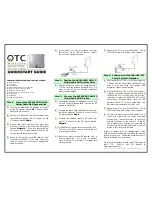
15
15
There are some limitations in our mesh which are listed below:
I. Due to the adoption of front-haul and backhaul sharing bandwidth to
connect various nodes in the Mesh network, if the Mesh agent is in a
daisy-chain configuration, each layer of connected nodes needs to
simultaneously handle communication with both upper-layer nodes and
lower-level devices. As a result, the available bandwidth speed will be
halved and evenly distributed. Based on this limitation, we recommend that
users assemble the Mesh network using Ethernet cables to connect the
nodes. This will avoid rate loss due to shared bandwidth (achieving
lossless conditions). If users must connect the nodes wirelessly, we
suggest forming a star topology network to prevent significant rate
reduction caused by multi-tiered connections.
II. All client devices connect to the Mesh network through the front-haul interface of
each node, while the connection between nodes relies on the backhaul bandwidth
to reach the controller and then access the Internet. In other words, the speed at
which clients connect to the Internet cannot exceed the backhaul bandwidth. Users
can configure their preferred band for the backhaul using the GUI. Here are the
maximum rates achievable when using each band as backhaul:
-
6GHz with 160MHz bandwidth: DL1201Mbps/UL1201Mbps (default using the
maximum available 6GHz bandwidth).
-
5GHz with 80MHz bandwidth: DL1201Mbps/UL1201Mbps (default using 5GHz
bandwidth to avoid DFS radar interference or CAC connection wait).
-
2.4GHz with 20MHz bandwidth: DL286Mbps/UL286Mbps (default using 2.4GHz
bandwidth to avoid interference from neighboring 40MHz bandwidth signals)
III. Limitations of the W6 series Mesh: A maximum of one cont three
agents are allowed. Products that can act as controllers: Predator Connect
X5/W6/W6m, Acer Connect Vero W6m. Products that can act as agents:
Predator Connect W6/W6m, Acer Connect Vero W6m. Users will be
reminded to avoid adding a fourth agent. When a user attempts to add a
fourth agent, the fourth agent will be forcibly factory reset to the router
state. The more agent nodes are connected; the more devices share the
bandwidth. Particularly in daisy-chain topology networks, we recommend
keeping the number of agents connected to three or fewer.
IV. All devices are factory-defaulted as routers. Users can change the device
role (e.g., Mesh controller, Mesh agent, or bridge) through Quick Setup.
V. Once a device has been set as a Mesh controller, Mesh agent, or bridge,
changing the device role requires restoring the device to its factory settings
before the role change can be made. Note: When the current device is a
router, it can be changed to other roles such as Mesh controller, agent, or
bridge (using GUI operation mode or Quick Setup).
VI. Currently, only the controller supports Guest & smart Home WiFi, while it
cannot be used in agent nodes. Agent nodes will not have any Guest &
smart Home WiFi options.















































![Pentagram Cerberus [P 6367] Installation And Operation Manual preview](http://thumbs.mh-extra.com/thumbs/pentagram/cerberus-p-6367/cerberus-p-6367_installation-and-operation-manual_1524254-01.webp)
